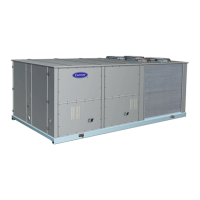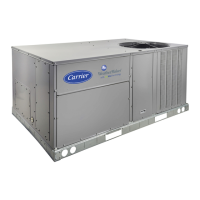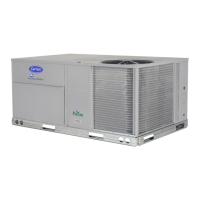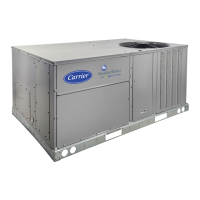67
Building Pressure SETP (BP.SP)
This setpoint is the building pressure control setpoint. If the
unit is configured for modulating building pressure control,
then this is the setpoint that the control will control to.
Power Exhaust on Setp.1 (BP.P1)
When configured for building pressure control type BP.CF = 1
(constant volume two-stage control), the control will turn on
the first power exhaust fan when the economizer’s position ex-
ceeds this setpoint.
Power Exhaust on Setp.1 (BP.P2)
When configured for building pressure control type BP.CF = 1
(constant volume two-stage control), the control will turn on
the second power exhaust fan when the economizer’s position
exceeds this setpoint.
Modulating PE Algorithm Select (BP.SL)
This configuration selects the algorithm used to step the power
exhaust stages. This must be set to 1 at all times. The other se-
lections are not used.
Building Pressure PID Evaluation Time (BP.TM)
This configuration is the run time rate of the multiple stage
(modulating) power exhaust algorithm (BP.CF=2).
Building Pressure Threshold Adjustment (BP.ZG)
This configuration is not used. It currently has no effect on
building pressure control.
High Building Pressure Level (BP.HP)
This configuration is the threshold level above the building
pressure setpoint used to control stages of power exhaust when
BP.SL=1.
Low Building Pressure Level (BP.LP)
This configuration is the threshold level below the building
pressure setpoint used to control stages of power exhaust when
BP.SL=1.
CONSTANT VOLUME 2-STAGE CONTROL (BP.CF = 1)
OPERATION
Two exhaust fan relays will be turned on and off based on
economizer position. The two trip setpoints are BP.P1 and
BP.P2. If the economizer is greater than or equal to BP.P1, then
power exhaust stage 1 is requested and a 60-second timer is
initialized. If the economizer is 5% below BP.P1, then power
exhaust stage 1 is turned off. Also, if the economizer position
is less than BP.P1 and the 60-second timer has expired, power
exhaust stage 1 is turned off. The same logic applies to the sec-
ond power exhaust stage, except the BP.P2 trip point is moni-
tored. If the economizer position is greater than or equal to
BP.P2, then power exhaust stage 2 is energized and a 60-sec-
ond timer is initialized. If the economizer is 5% below BP.P2
the second power exhaust stage turned off. If the economizer is
less than BP.P2 and the 60-second timer has expired, second
stage power exhaust is turned off. For BP.CF=1, Table 66 illus-
trates the power exhaust stages 1 and 2, relay combinations
based upon Configuration
BP.MT (4 or 6 motors).
MULTIPLE POWER EXHAUST STAGE BUILDING PRES-
SURE CONTROL (BP.CF = 2) OPERATION
Building pressure control is active whenever the supply fan is
running. The control algorithm to be used (BP.SL=1) is a timed
threshold technique for bringing stages of power exhaust on
and off.
The number of power exhaust stages available for this control
algorithm is a function of the number of motors it supports.
This number of motors is defined by the Configuration
BP
BP.MT configuration. Table 67 illustrates the staging tables
for this control algorithm based on BP.MT.
The following configurations are used in the controlling of
building pressure with this algorithm:
• Configuration
BP
B.CFG
BP.HP (building pres-
sure high threshold level)
• Configuration
BP
B.CFG
BP.LP (building pres-
sure low threshold level)
• Configuration
BP
B.CFG
BP.TM (building pres-
sure timer)
This control function is allowed to add or select power exhaust
stages at any time, except that a delay time must expire after a
stage is added or subtracted. Any time a stage change is made,
a timer is started which delays staging for 10 * BP.TM sec-
onds. The default for BP.TM is 1, therefore the delay between
stage changes is set to 10 seconds.
The logic to add or subtract a stage of power exhaust is as follows:
• If building pressure (Pressures
AIR.P
BP) is greater
than the building pressure setpoint (Configuration
BP
BPSP) plus the building pressure high threshold level
(Configuration
BP
B.CFG
BP.HP) add a stage
of power exhaust.
• If building pressure (Pressures
AIR.P
BP) is less than
the building pressure setpoint (Configuration
BP
BP-
SP) minus the building pressure low threshold level (Config-
uration
BP
B.CFG
BP.LP), subtract a stage of
power exhaust.
VFD POWER EXHAUST BUILDING PRESSURE CON-
TROL (BP.CF = 3)
A 4 to 20 mA analog output from Economizer Control Board 1
(ECB-1, AO1) is provided as a speed reference for a field-in-
stalled VFD power exhaust accessory. If building pressure
(Pressures
AIR.P
BP) rises above the building pressure
setpoint (BP.SP) and the supply fan is on, then building pres-
sure control is initialized. Thereafter, if the supply fan relay
goes off or if the building pressure drops below the BP.SP mi-
nus the building pressure setpoint offset (BP.SO) for 5 continu-
ous minutes, building pressure control will be stopped. The 5-
minute timer will continue to reinitialize if the VFD is still
commanded to a speed > 0%. If the building pressure falls be-
low the setpoint, the VFD will slow down automatically. Con-
trol is performed with a PID loop where:
Error = BP – BP.SP
K = 1000 * BP.RT/60 (normalize the PID control for run rate)
P = K * BP.P * (error)
I = K * BP.I * (error) + “I” calculated last time through the PID
D = K * BP.D * (error – error computed last time through the
PID)
VFD speed reference (clamped between BP.MN and BP.MX%)
= P + I + D

